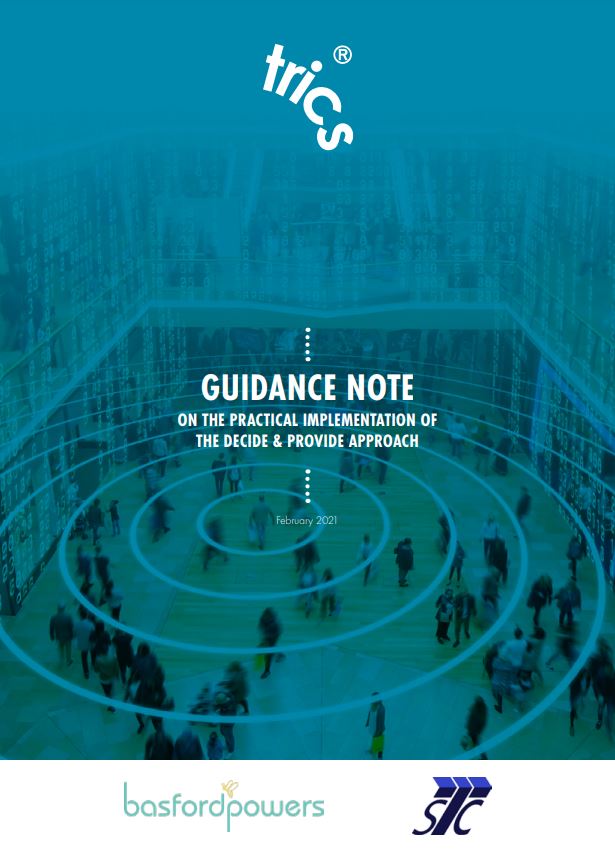As TRICS Consortium Limited (TRICS) is responding to the fact that the world is experiencing significant change in relation to social, technological, economic and environmental drivers (now accelerated by a global pandemic), by issuing a new guidance document “Guidance Note on the practical implementation of the Decide & Provide approach”, the transport planning profession is still left with a huge challenge. In the face of deep uncertainty, I have no doubt that the “Predict and Provide” (P&P) paradigm that has framed transport planning processes will eventually give way to the “Decide and Provide” (D&P) paradigm. In light of climate emergency, now more than ever before we have to decide what future we want and provide accordingly, whilst also dealing with all the uncertainty along the way.
Government transport policies have traditionally focused on predicting future demand to provide capacity (P&P) but in recent years have contemplated new approaches which may provide the opportunity for change by seeking to consider uncertainty more explicitly. TRICS has identified the specific need to develop clear and concise guidance for practitioners to better understand and implement the D&P approach, given this lack of such guidance in this area. This is very welcomed indeed! Whilst the lack of guidance clearly has hindered us, as practitioners, I would however say that it is still the least of our daily struggle… speaking for myself, the huge challenge, when adopting said approach will continue being:
- Convincing the Highway Authority of the D&P approach, rather than predicting a worst case assessment (P&P);
- Convincing my Client to pay for the increased scope of work by undertaking scenario testing, and the time taken to convince the Highway Authority; and
- Explaining to the layperson (including Planning Committee Members) that there isn’t a definitive answer (but a range of possible outcomes).
TRICS says “This TRICS Guidance has been prepared at the start of an anticipated period of transition heralded by the publication of Planning for the Future White Paper in August 2020 (“the Planning White Paper”). The Planning White Paper presents a series of proposals for the wholesale and radical reform of England’s planning system. This transition is also heralded by the DfT’s Transport Decarbonisation Plan (TDP), which is anticipated in Spring 2021 and will set out an ambitious plan to accelerate the decarbonisation of transport. All of which emphasise the importance of adopting a D&P approach at the earliest possible stage, as part of the plan-making’s visioning and (Growth, Renewal and Protected) area identification processes.”

Changing policy will eventually filter down to the decision makers and the Highway Authority, I am sure, however, it takes a (very) long time in my experience. We are still dealing with Local Planning Authorities that have 20 year old parking standards, requiring a minimum of 2 or 3 vehicular parking spaces in town centres!
Whilst I have to admit I have not had time to digest the TRICS document to the level of detail that I would like, it is evident that the “worked examples” do not provide a clear trend in change of travel demand in regard for many of the development types (Food Retail Store being the clear exception). Adopting the idea of a “fan of influence”, building in a resilience in our approach, is definitely the way forward. Scenario testing has, and always will be, useful, providing we are given the time and budget to undertake them. However, the challenge will be convincing my clients that it is worth my time, but more importantly, their money. In particular, if the Highway Authority does not give any weight to the additional analysis and still revert to the old P&P way of thinking.
Nevertheless, coinciding with the release of the TRICS document we were on the same day (22 February 2021) provided with a “Road Map” out of the prevailing pandemic by Boris Johnson, so maybe I should see this as a good sign and be less cynical and things will change for the better. Maybe the 2021 Census will also provide us with clarity when it is published; providing my profession with a clearer picture of what changes have already taken place. But, the big question will be how relevant the 2021 Census is, considering the prevailing restrictions due to COVID-19 on 21 March 2021 when it is due to be undertaken!
Whatever we do, we just need to make sure that we create better places for people in years to come; places to meet, play, work, live and enjoy life. In the words of the Chartered Institute of Highways and Transportation (CIHT): “Our quality of life depends on transport and easy access to jobs, shopping, leisure facilities, and services”.

Daniel Ekstrand
Associate Director
020 7119 1158
07747 561849
daniel.ekstrand@tpa.uk.com




